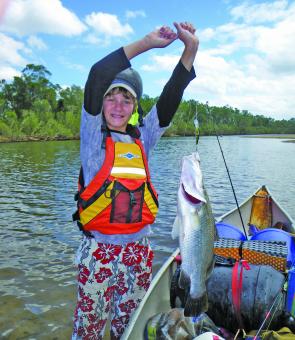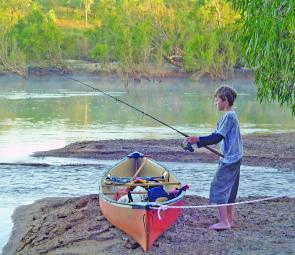Fishing from a canoe is one skill but there are also a lot of opportunities to fish from the bank – usually early morning and late afternoon around the camp. Having a good pair of walking shoes comes in very handy, as the terrain is invariably rocky where the best fishing is to be had. Heavy-duty trekking shoes are too big and cumbersome for canoeing, so just use a pair of runners with a good tread.
I and my mate Terry McClelland use Asics Trabucos; when the soles lost their cushioning they became river shoes. I take one pair for the river and fishing rough terrain and a pair of Crocs (not the bitie type) for around camp and easy fishing. The Crocs are super light and dry in a flash. They are well ventilated but still keep most of the sand and pebbles out.
Where there are barra there are estuarine crocodiles. If the barra can travel upriver unimpeded, so can crocs. Even though the word from old times may be that there are no salties in a particular stretch, it’s not worth betting your life on it. There was a great article in the October issue of QFM (Croc Safe, p66) that says it all.
From my perspective, the key points are these: fish from a protected location, stand well back from the water and walk the bank well back from the water. The late Steve Irwin used to say that a croc can lunge out of the water about half its body length, so that means you need to stay about 3m back from, or above, the water if you’re fishing out in the open. It is possible to fish closer if you are standing behind a protective screen of logs or a canoe, but always be vigilant. Most bank fishing is done in the early morning or late afternoon, when salties are more active.
The majority of our fishing is done with lures but it pays to have a bit of bait fishing gear for the kids when they lose patience with casting and retrieving. I have found that a small jighead loaded with a Berkley 3” pumpkinseed (freshwater scented) minnow grub is just perfect for kids. It works like a lure when retrieved, and just as well as bait when you let it sink to the bottom. When the kids were younger, I found it the perfect compromise. They could catch a barra or sooty if they worked it as a lure and then catties and sooties when they wearied of flicking.
The good old piece of salami on a hook is great bait for sooties and not as popular with catfish, so it also makes a great fall-back option for the kids. If you want to be a bit more refined, there are plenty of mussels on the sand banks, and ample opportunity to collect a few during the day’s paddle to use near camp in the afternoon.
The majority of anglers on our canoe trips use braid between 20 and 30lb, with 20 or 30lb leader, depending on whether it is barra country or not. For sooties, 20lb is fine but it pays to go up to 30lb leader for barra, even though the fish aren’t monsters. Still, seeing as we are fishing right at the upper extent of the barra’s range in the rivers, 15lb can pull a better than average barra.
I have found Sure Catch fluorocarbon leader to be perfect and I use it for all my leader applications. It is hard, very transparent in the water and knots really well.
I tie straight onto the braid using a double uni knot, with only two loops for the leader and eight for the braid. Using only two loops with the leader causes the tag to lie parallel to the line when snugged down and has never let go, even at the reef under extreme load conditions. Any more than two loops with the leader and the tag always ends up at right angles to the line and catches more readily on the runners when casting and especially when retrieving.
To cut the leader I normally use pliers that crush as they cut (the cutting blades meet), rather than scissor-style cutters. Pliers create a small flattened end on the leader, helping to stop it from slipping through the knot under load. Due to room and weight limitations, I only take my Leatherman canoeing, which has a scissor-style cutting mechanism, so I cut the leader with about 2mm protruding, then crush it with the pliers to stop it slipping from the constant pounding it gets going through the runners. Eight turns with the braid prevents it from slipping but still lets you snug it down firmly. It is the quickest and easiest way I have found to join braid and leader.
By far the most successful lure on our canoe trips has been the Prawnstar Jr in the el natural and honey pot colours (this is one of two products mentioned in the series of articles that I am sponsored by). I always add an oval-shaped orange bead between the hooks to add more colour. It also stops the hooks from fouling each other and it makes it easier to dislodge from snags.
The other modification I make is to replace the hooks with a size 6, black chrome Owner, treble at the tail and a size 4 under the belly. Over 70% of our barra have been caught using Prawnstars. They also troll really well at canoe paddling speed and are very snag resistant.
During our trip two years ago I stood on a rock at the top of a perfect set of barra rapids and tried a variety of other prawn-style lures in various colours. I was so confident that there would be barra there that I persisted with the spot for over half an hour, regularly changing lures. I eventually went back to the tried and proven honey pot Jr Prawnstar and hooked up first cast. I ended up catching three barra in short succession. Coincidence or not; who knows? Either way, it sure helps to have confidence in the lure on the end of your line.
I join my swimming lures to the leader using a Rapala or Harrison loop, which doesn’t need to be locked off when using Sure Catch fluorocarbon but does with softer leaders. Lures under 10cm in length have proven to be the best, with deep divers getting better results. Over the years the only colour which seems to do better than others is blue and silver/white, though the difference is not striking.
Soft plastics work a treat but you tend to go through quite a lot in a trip. Standard jighead set-ups tend to snag up a lot, as the best fishing country is full of logs and rocks. SWIK soft plastics by Tropic Angler (sponsored product) are far more durable than most and work really well using a weedless jighead set-up. Some of the biggest barra I have taken on our canoe trips have fallen to a SWIK in the livebait and chartreuse livebait colours.
Whatever lure is on the end of your line, the secret is to have confidence in the lure and keep putting it in places where barra lurk. One sure thing I have learned over the years is persistence pays off.
That wraps up this series on expedition canoeing and the last word goes to Brad Weaver who said at the conclusion of his first trip in 2009 that, “I would rate that trip in the top 10 experiences of my life.”
When you consider that this verdict comes from a guy who has lived and worked overseas and travelled the world extensively, it is high praise indeed!
Reads: 2191
Lures under 10cm in length have proven to be the best, with deep divers getting better results.

It is possible to fish closer to the water if you are standing behind a protective screen of logs or a canoe but always be vigilant.

Expedition leader, Terry McClelland, with a typical freshwater barra.

The late Steve Irwin used to say that a croc can lunge out of the water about half its body length, so that means being about 3m back from, or above, the water if fishing out in the open.




